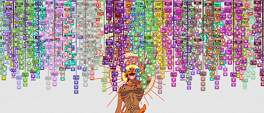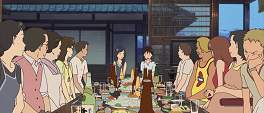Following up the critically acclaimed and astoundingly brilliant The Girl Who Leapt Through Time was never going to be an easy prospect but with a timbre shift sure to cement Mamoru Hosoda's role as a world-class director, Summer Wars proves to be a worthy successor both creatively and aesthetically. Taking the fluidity Madhouse gifted his previous film with, the animation is dialled up until innumerable characters are all raucously moving at once - breathing, laughing, talking and living on screen. Pomp and flair help avoid the stereotypes that so often go with virtual-world stories and though it still degenerates into a touch typing marathon, the excitable charm it displays throughout elevates it from the standard, tepid blockbuster fare.
Kenji is asked by one of the prettiest girls in school, Natsuki, to help with a summer job; unbeknownst to him however is that her grandmother is soon to be turning ninety and Natsuki has told her family about a fictional fiancé that he must now assume the role of. Travelling out into the countryside around Ueda, he is introduced to the bustling, varied personalities of Natsuki's extended family and the palatial house and grounds that have belonged to the Shinohara clan for generations. In the virtual world of OZ however, a malevolent entity is wreaking untold havoc - shutting down vital utilities and gobbling up user accounts with nobody able to stop it. Inconvenience is only the start when it transpires the entity has a close link with the Shinoharas and it may only be Kenji, Natsuki and other members of the family who can stop real world devastation from occurring.
The world of OZ is a technicolour explosion of stark lines and clean iconography - the superflat design inspiration of Takashi Murakami gift the film a strong visual identity, however it is the soft and naturalistic landscapes of Nagano prefecture where the majority of the story takes place. The juxtaposition between the two areas is as brazen as intended: whereas the denizens of OZ talk through speech bubbles and exaggerated gesticulations of their often anthropomorphic avatars, the family meals of the Shinohara household are rife with subtext, inferences and replete with all the bedlam a large and close-knit family can generate. Communication plays a starring role throughout; whether it is cellular or rotary phone calls, video conferencing, SMS texting and chat-room style avatar collections facilitated by OZ or the fine detailing of hand gestures and eye movements exhibited by the barrage of key characters. Judgement is never passed on any method and the film is neither a celebration or a warning of these different ways to interact.
OZ and the invasion by the ludicrously named entity, Love Machine, provides the plot for Summer Wars but it is at heart a character drama. Kenji, who begins as the protagonist, is left mostly unexplored and other more esoteric cast members are given the spotlight such as the shrewd grandmother Sumiko or the wasp-like Wabisuke. Kenji initially plays the straight-man to the genial maelstrom that is the family gathering but all too quickly he is overtaken by the keen tempo the film sets and the more outlandish characters suit this perfectly. Yoshiyuki Sadamoto's character designs shine their brightest here and though ones like the smitten police officer end up being caricatures, this is more a symptom of the bulging roster than poor writing. It says volumes when even incidental members of the family can be remembered long after the credits have rolled.
This breadth-first approach to development isn't without its troubles though. Wabisuke - who had a guiding hand in the troubles that afflict OZ throughout the film - is never given the closure his character deserves and only a short epilogue concludes his key role; similarly his motivations for the villainy he is accused of are not explored and only his affection for Sumiko is stated. Kenji also suffers from a lack of context: his affection for Natsuki is implied more as adoration, yet the ancillary materials for the film describe a pre-existing crush. These are niggling concerns however for what is otherwise a brilliantly crafted selection of characters that despite their differences have a delightful chemistry together and, crucially, feel like a coherent and loving family.
The strong cast lamentably doesn't make up for the utterly ludicrous plot: a blend of virtual worlds, rogue AIs, questionable mathematics and enforced time limits. The world of OZ patches over many of the most egregious problems with computer focused films, namely the boredom suffered from watching a character type into a monochromatic terminal as they go about their business. Unfortunately in this day and age, especially for younger viewers who are more technologically savvy, many of the pivotal ideas presented don't gel with the otherwise real world trappings the film demonstrates. To even the most casual observer the concept of numerous disparate services - traffic lights, health monitors, water flow regulators - all under one umbrella security system is patently ridiculous. It's difficult to believe this wasn't entirely purposeful however. Despite using Dell laptops, Sony monitors and running Windows 7 within a virtual machine on a Linux desktop, the film deals in spectacle over nuance and abstraction over detail. The OZ interface is instantly recognisable to all and though it may further a completely fictitious ideal of how computers work, it doesn't bog down the otherwise riotously enjoyable characters.
Both the sterile cleanliness of OZ's interface and the lush vistas of Ueda are rendered with a level of detail only a few top tier studios in Japan could match; Madhouse have once again proven that with the right talent and the right budget, abject beauty can be attained. The opening journey taken by Kenji and Natsuki is a montage of different methods of transport, each one gifted the kind of detail seen in works by Makoto Shinkai but injected with the whimsy of summer rather than the introversion of winter. Other areas see the return of the ribbon-like device first seen in The Girl Who Leapt Through Time and even shows hints of Satoshi Kon's Paprika in some of the busy, climactic moments. The virtual world of course echoes Superflat Monogram but also some of the more outlandish creations from the auteur Studio 4°C. Bind these with a most emotive style of animation and the result is unique, identifiable and addictive to watch.
Summer Wars presents itself in broad strokes and, true to it's name, holds the soul of a summer blockbuster. It walks the line between a brainless extravaganza and ponderous meditation; knowingly simplified but never dumbed down it is a shift from the poignant time-travel of Mamoru Hosoda's previous film and is an instantly accessible romp through a colourful and expressive imagination. Enjoyment and emotion trump the need for an overarching message and the film deserves all the plaudits and financial success it has so far obtained.
















This was the impression I had as well. As unavoidable was it was (without a major script rewrite, anyway), there were too many characters. But then, the movie was about the overall experience and the whole spectacle of the thing.
It didn't have the exquisite character study of Tokikake but I agree with your conclusion that it intentionally 'presents itself in broad strokes'. It wasn't a 'personal' film; for me it was about families and crowds, not individuals. I was fortunate enough to see it in a cinema with a large group of friends, which is probably the best setting to see it in. It's intended to be a bold, bright and fun movie; it succeeded!